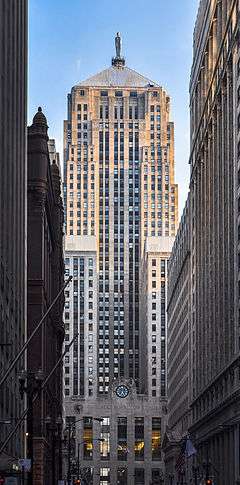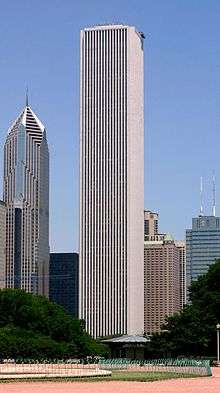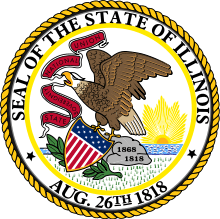Economy of Illinois
|
Chicago Board of Trade building | |
| Statistics | |
|---|---|
| GDP | $775,007 million (2015) [1] |
GDP per capita | $60,265 (2015) [2] |
Population below poverty line | 12.2%[3] |
| 0.469[4] | |
Labor force | 6,488,200 (May 2015) [5] |
| Unemployment | 6.6% (May 2016) [6] |
| Public finances | |
| Revenues | $29,761.862 million[7] |
| Expenses | $19,831 million[8] |
The economy of Illinois includes many industries. The Chicago metropolitan area is home to many of the United States' largest companies, including Boeing, McDonalds, Motorola, and United Airlines. The Chicago area economy headquarters a wide variety of financial institutions, and is home to the largest futures exchange in the world, the Chicago Mercantile Exchange.
The 2015 total gross state product for Illinois was $775 million, placing it fifth in the nation. The 2013 median household income was $56,210.[9] The state's industrial outputs include machinery, food processing, electrical equipment, chemical products, publishing, fabricated metal products, transportation equipment, petroleum and coal.
Agriculture
Most of the state of Illinois lies outside of the Chicago urban area and inside the North American Corn Belt. Corn, soybeans, and other large-field crops are grown extensively. These crops and their products account for much of the state's economic output outside of Chicago. Much of the field crop is remanufactured into feed for hogs and cattle. Dairy products and wheat are important secondary crops in specific segments of the state. In addition, some Illinois farmers grow specialty crops such as popcorn and pumpkins. The state is the largest producer of pumpkins among the U.S. states.[10] There is a large watermelon growing area centered on Lincoln, Illinois. Illinois wine is a growing industry. In December 2006, the Shawnee Hills were named Illinois's first American Viticultural Area (AVA).[11]
Manufacturing
Illinois's manufacturing sector grew out of its agricultural production. A key piece of infrastructure for several generations was the Union Stock Yards of Chicago, which from 1865 until 1971 penned and slaughtered millions of cattle and hogs into standardized cuts of beef and pork.
In 1893 Illinois manufacturers formed the Illinois Manufacturers' Association in opposition to the Sweatshop Law of 1893 that prohibited child labor and mandated an eight-hour workday.[12][13] Governor Peter Altgeld had made Florence Kelley the Chief Factory Inspector for the state of Illinois.[14] The association sponsored a number of cases which led to the Illinois Supreme Court finding that Section 5 of the Act, which limited women's working weeks to 48 hours and their day to eight hours, unconstitutional in 1895.[12][15] After Governor Altgeld was not re-elected in 1896 and Kelley was removed from her position, flagrant violations of the child labor provision were reported.[12]
The centralized location of Illinois made it a key manufacturing hub, especially for farm machinery and specialty motor vehicles. Smaller Cities like Aurora, Peoria, Decatur, Rockford and other cities became major manufacturing centers in the 20th century. In downstate Illinois, the John Deere Company became one of the world's largest makers of farm machinery, and Caterpillar achieved similar dominance in its diversified line of off-road vehicles.
The Chicago area, meanwhile, began to produce significant quantities of telecommunications gear, electronics, steel, automobiles, and industrial products.
As of 2004, the leading manufacturing industries in Illinois, based upon value-added, were chemical manufacturing ($16.6 billion), food manufacturing ($14.4 billion), machinery manufacturing ($13.6 billion), fabricated metal products ($10.5 billion), plastics and rubber products ($6.8 billion), transportation equipment ($6.7 billion), and computer and electronic products ($6.4 billion).[16]
Services
By the early 2000s, Illinois's economy had moved toward a dependence on high-value-added services such as financial trading, higher education, logistics, and medicine. In some cases, these services clustered around institutions that hearkened back to Illinois's earlier economies. For example, the Chicago Mercantile Exchange, a trading exchange for global derivatives, had begun its life as an agricultural futures market.
The Wall Street Journal summarized Illinois's economy in November 2006 with the comment that "Chicago has survived by repeatedly reinventing itself." [17]
Flash index
The Institute of Government and Public Affairs at the University of Illinois publishes a "flash-index" that aims to measure expected economic growth in Illinois. The indicators used are corporate earnings, consumer spending and personal income. These indicators are measured through tax receipts, adjusted for inflation. 100 is the base, so a number above 100 represents growth in the Illinois economy, and a number below 100 represents a shrinking economy.[18] Data from the index, from 6/1981 to the present, can be found here.
See also
References
- ↑ http://research.stlouisfed.org/fred2/graph/?id=ILNGSP
- ↑ http://research.stlouisfed.org/fred2/graph/?id=ILPCPI
- ↑ http://www.census.gov/compendia/statab/2011/ranks/rank34.html
- ↑ http://factfinder.census.gov/servlet/DTTable?_bm=y&-context=dt&-ds_name=ACS_2009_1YR_G00_&-_geoSkip=0&-CONTEXT=dt&-mt_name=ACS_2009_1YR_G2000_B19083&-tree_id=307&-_skip=0&-redoLog=false&-geo_id=04000US01&-geo_id=04000US02&-geo_id=04000US04&-geo_id=04000US05&-geo_id=04000US06&-geo_id=04000US08&-geo_id=04000US09&-geo_id=04000US10&-geo_id=04000US11&-geo_id=04000US12&-geo_id=04000US13&-geo_id=04000US15&-geo_id=04000US16&-geo_id=04000US17&-geo_id=04000US18&-geo_id=04000US19&-geo_id=04000US20&-geo_id=04000US21&-geo_id=04000US22&-geo_id=04000US23&-geo_id=04000US24&-geo_id=04000US25&-geo_id=04000US26&-geo_id=04000US27&-geo_id=04000US28&-geo_id=04000US29&-geo_id=04000US30&-geo_id=04000US31&-geo_id=04000US32&-geo_id=04000US33&-geo_id=04000US34&-geo_id=04000US35&-geo_id=04000US36&-geo_id=04000US37&-geo_id=04000US38&-geo_id=04000US39&-geo_id=04000US40&-geo_id=04000US41&-geo_id=04000US42&-geo_id=04000US44&-geo_id=04000US45&-geo_id=04000US46&-geo_id=04000US47&-geo_id=04000US48&-geo_id=04000US49&-geo_id=04000US50&-geo_id=04000US51&-geo_id=04000US53&-geo_id=04000US54&-geo_id=04000US55&-geo_id=04000US56&-geo_id=04000US72&-search_results=01000US&4-_showChild=Y&-format=&-_lang=en&-_toggle=
- ↑ http://research.stlouisfed.org/fred2/data/ILLFN.txt
- ↑ http://www.chicagotribune.com/business/ct-illinois-april-unemployment-0520-biz-20160519-story.html
- ↑ Eljalde Ruiz, Alexia (19 May 2016). "Illinois' unemployment rate rises to 6.6 percent in April". Chicago Tribune. http://www.census.gov/govs/statetax/1006costax.html
- ↑ http://nasbo.org/LinkClick.aspx?fileticket=w7RqO74llEw%3d&tabid=79
- ↑ http://www.deptofnumbers.com/income/illinois/
- ↑ http://www.agr.state.il.us/newsrels/r1022041.html Illinois Department of Agriculture
- ↑ "Matter of taste: Area in southern Illinois gets Shawnee Hills designation". Springfield, Ill. State Journal-Register. 2006-12-14. p. 21.
- 1 2 3 Illinois: A Descriptive and Historical Guide. US History Publishers. 1939. p. 84. ISBN 9781603540124.
- ↑ "Illinois Manufacturers Organize: They Will Protect Their Interests in the Female Labor Law". Chicago Daily Tribune. September 30, 1893.
- ↑ Sklar, Kathryn Kish (1995). Florence Kelley and the Nation's Work: The Rise of Women's Political Culture, 1830-1900. New Haven: Yale University Press. pp. 254–255. ISBN 9780300072853.
- ↑ Mayer, Levy (1913). Opinions rendered to the Illinois Manufacturers' Association from January 1, 1899, to January 1, 1907. Chicago, Ill.: Illinois Manufacturers' Association. p. 42.
- ↑ Manufacturing in Illinois. Illinois Department of Commerce and Economic Opportunity.
- ↑ Brat, Ilan, "Tale of a Warehouse", Wall Street Journal, Nov. 8, 2006, page A1.
- ↑ http://www.igpa.uiuc.edu/programs/flashindex.asp IGPA Flash Index


